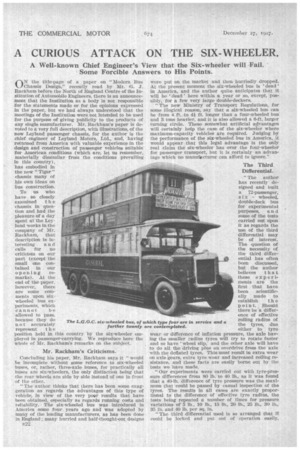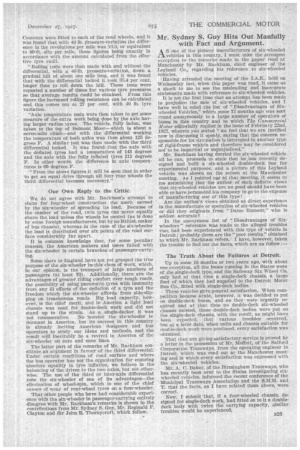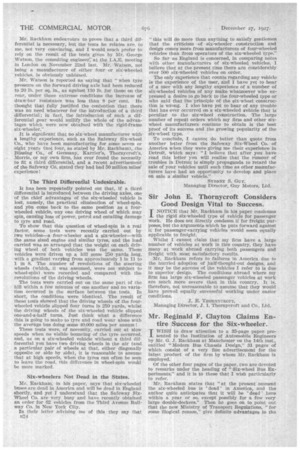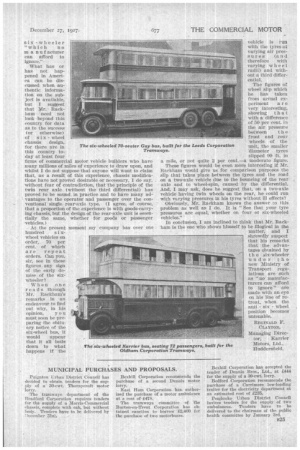A CURIOUS ATTACK• ON THE SIX-WHEELER.
Page 36

Page 37

Page 38

Page 39

If you've noticed an error in this article please click here to report it so we can fix it.
A Well-known Chief Engineer's View that the Six-wheeler will Fail. Some Forcible Answers to His Points.
rIN the title-page of a paper on "Modern Bus V./Chassis Design," recently read by Mr. G. S. Rackham before the North of England Centre of the Institution of Automobile Engineers, there is an announcement that the Institution as a body is not responsible for the statements made or for the opinions expressed in the paper, but we had always understood that tile meetings of the Institution were not Intended to be used for the purpose of giving publicity to the products of any single manufacturer. Mr. Rackham's paper is devoted to a Very full description, with illustrations, of the new Leyland passenger chassis, for the author is the chief engineer of Leyland Motors, Ltd„ and, having returned from America with valuable experience in the design and construction of passenger vehicles suitable for American conditions (which are, let us remember, materially dissimilar from the conditions prevailing In this country), has embodied in the new " Tiger " chassis many of his own ideas on bus construction.
To us who have so closely examined t h e chassis in question and had the pleasure of a day spent at the Leyland works in the company of Mr.
• Rackh am, that description is in
teresting an d calls for no criticism on. our part (except the small one contained in our opening remarks). At the end of the paper, however, there are some comments upon .sixwheeled bus experiments, which cannot be allowed to pass, because they do not accurately represent t h e position held in this country by the six-wheeler employed in passenger-carrying. We reproduce here the whole of Mr. Rackliam!s remarks on the subject.
. Mr. Rackharn's Criticisms.
Concluding his paper, Mr. Rackbam says it "would be incomplete without some reference to six-wheeled buses, or, rather, three-axle buses, for practically all buses are six-wheelers, the only distinction being that the rear wheels are side by side instead of one in front of the other.
"The author thinks that there has been some exaggeration as regards the advantages of this type of vehicle, in view of the Very poor results that have been obtained, especially as regards running cogts and reliability. The six-wheeled bus was introduced in America some four years ago and was adopted by many of the leading manufacturers, as has been done in England ; many hurried and half-thought-out designs
n22 •
were put on the market and then hurriedly dropped.• At the present moment the six-wheeled bus is 'dead ' in America, and the author quite anticipates that it will be ' dead ' here within a year or so, except, possibly, for a few very large double-deckers.
"The new Ministry of Transport Regulations, for some illogical reason, say that a six-Wheeled bus can be from 4 ft. to 41, ft. longer than a four-wheeled bus. and 3 tons heavier, and it is also allowed a (I-ft. larger turning circle. These somewhat artificial advantages will certainly help the case of the six-wheeler where maximum-capacity vehicles are required. Judging by the performance of the six-wheeled bus in America, it would appear that this legal advantage is the only real claim the six-wheeler has over the four-wheeler for passenger transport, but it is certainly an advantage which no manuffcturer can afford to ignore."
The Third Differential.
"The author has recently designed and built a 72-passenger, six wheeled, double-deck bus for experimental purposes, a n d some of the tests carried out upon it as regards the use of the third differential may be of interest. The question of the necessity of the third differential has often been discussed, but the author believes that these experiments are the first that have been scientifically made to
establish t h a point. Should there be a difference of effective rolling radius of the tyres, due either to tyre wear or difference of inflation pressure, the axle having the smaller radius tyres will try to rotate faster and so have 'wheel slip, and the other axle will have to do all the driving plus an overdrive from the -axle with. the deflated tYres.. This-must result in extra wear on axle gears, extra tyre wear and increased rolling resistance, and these facts are easily borne out by the tests we have made.
"Our experiments were carried out with tyre-pressure differences from 80 lb. to 40 lb., as it was found that a 40-lb. difference of tyre pressure was the maximum that could be passed by casual inspection of the tyres. The results in all cases are exactly propertIonal to the difference of effective tyre radius, the tests being repeated a number of times for pressure variations of 5 lb., 10 lb., 15 lb., 20 lb., 25 lb., 30 lb., 35 lb. and 40 lb. per sq. in.
"The third differential used is so arranged that it could be locked and put out of operation easily. Counters were fitted to each of the road wheels, and it was found that with 40 lb. tirsure-variation the difference in the revolutions per mile was 10.5, or equivalent to 99-ft. slip per mile, these figures being exactly in accordance with the amount calculated from the effective tyre radii, "Roiling tests were then made with and without the differential, with a 40-lb. pressure-variation, down a gradual hill of about one mile long, and it was found that with the differential locked it took 35.4 per cent. longer time to roll down the hill. These tests were repeated a number of times for various tyre pressures so that average results Could be obtained. From this figure the increased rolling resistance can be calculated and this comes out at 27 per cent. with 40 lb. tyre variation.
"Axle temperature tests were then taken to get some measure of the extra work being done by the axle having larger radius tyres. The vehicle, fully laden, was taken to the top of Belmont Moor—which is about a seven-mile climb—and with the differential working the temperature of both axles was then about 125 degrees F. A similar test was then made with the third differential locked. It was found that the axle with the deflated tyres had a temperature of 143 degrees and the axle with the fully inflated tyres 212 degrees F. In other words. the difference in axle temperatures is 69 degrees F.
"From the above figures it will he seen that in order to get an equal. drive through all four rear wheels the third differential becomes necessary."
Our Own Reply to the Critic.
We do not agree with Mr. Rackham's attempt to claim for four-wheel construction the merit earned by the six-wheeler of spreading its load. Because of the camber of the road, twin tyres can never equally share the load unless the wheels be canted (as is done by some foreign manufacturers, but by no British maker of bus chassis), whereas in the case of the six-wheeler the load is distributed over six points of the road surface considerably far apart.
It is common knowledge that, for some peculiar reasons, the American makers and users failed with the six-wheeler in certain branches of passenger-carrying.
Some users in .England have not yet grasped the true purpose of the six-wheeler in this class of work, which, in our opinion, is the transport of large numbers of passengers (at least 70). Additionally, there are the advantages of greater riding comfort over rough roads, the possibility of using pneumatic tyres with immunity from any ill effects of the deflation of a tyre and the freedom which the six-wheeler affords from side-slipping on treacherous roads. Big load capacity, however, is the chief merit, and he America a light load chassis was used for double-deck work and did not stand up to the strain. As a single-decker it was not remunerative. No Wonder the six-wheeler is dormant in America, but its success in this country is already inciting American designers and bus operators to study our ideas and methods, and the result will inevitably he a revival in America of the six-wheeler on sure and sane lines.
The latter part of the remarks of Mr. Rackhare constitute an argument in favour of the third differential. Under certain conditions of road surface and where the bus operator has not the organization for ensuring absolute equality in tyre inflation, we believe in the balancing of the drives to the two axles, but not-otherwise. The use of the third or inter-axle differential robs the six-wheeler of one of its advantages—the elimination of wheel-spin, which is one of the chief causes of wear of rear-wheel tyres on a four-wheeler.
That other people who have had considerable experience with the six-wheeler in passenger-carrying entirely disagree with Mr. Rackham's remarks is shown in the contributions from Mr. Sydney S. Guy, Mr. Reginald F. Clayton and Sir John E. Thornycroft, which follow.
Mr. Sydney S. Guy Hits Out Manfully with Fact and Argument.
A S one of the pioneer manufacturers of six-wheeled il.vehicles in this country, I must take the strongest exception to the remarks made in the paper read at Manchester by Mr. Itackhain, chief engineer of the Leyland Co., regarding his reference to six-wheeled vehicles.
Having attended the meeting of the I.A.E., held on Wednesday last, when this paper was read, it came as a shock to me to see the misleading and inaccurate statements made with reference to six-wheeled vehicles.
It is not the first time that an attempt has been made to prejudice the sale of six-wheeled vehicles, and I have well in mind the list of "Disadvantages of Sixwheeled Vehicles," which some 12 months ago was sent round anonymously to a large number of operators of buses in this country and to which The Commercial Motor editorially replied in the issue of February 22nd, 1927, wherein you stated "we feel that we are justified now in discussing it openly, saying that the concern responsible for its circulation is interested in another type of rigid-frame vehicle and therefore may be considered not to be impartial or unprejudiced."
Mr. Rackham having decried the six-wheeled vehicle all he can, proceeds to state that he has recently de' signed and built a six-wheeled double-deck bus for experimental purposes, and a picture of this Leyland vehicle_ was shown on the screen at the Manchester meeting._ As I pointed out at that meeting, it seems to me astonishing that the author of such definite views that six-wheeled vehicles are no good should have been able to have persuaded his company to go to the expense of manufacturing one of this type!
Are the author's views obtained as direct experience in the manufacture or operation of six-wheeled vehicles or did they originate from "Dame Rumour," who is seldom accurate? .
In the anonymous list of "Disadvantages of Sixwheelers " reference was made to the alleged troubles that had been experienced with this type of vehicle in Detroit ; probably these are the " poor results" obtained to which Mr. Rack-ham refers. I have, however, taken the trouble to find out the facts, which are as follow :— The Truth About the Failures at Detroit.
Up to some 18 months or two years ago, with about one exception, all the buses running in the States were of the single-deck type, and the Safeway Six Wheel Co. only had at that time a single-deck chassis, a large fleet of which they had supplied to the Detroit Motor Bus Co., fitted with single-deck bodies.
. These vehicles gave g.eneral satisfaction. When competition became acute, however, it was decided to put on double-deck buses, and as they were urgently required and at that time no double-deck six-wheeled chassis existed, these double-deck bodies were put on the single-deck chassis, with the result, as might have been expected, that various troubles occurred, hut at a later date, when units and chassis suitable for double-deck work were produced, every satisfaction was obtained.
That they are giving satisfactory service is proved by a letter in the possession of Mr. Moffett, of the Salford Corporation Tramways, from the operating engineer in Detroit, which was read out at the Manchester meeting and in which every satisfaction was expressed with the six-wheeled vehicles.
Mr. A. C. Baker, of the Birmingham Tramways, who has recently been over to the States investigating sixwheeled vehicles, informed the recent conference of the Municipal Tramways Association and the S.M.M. and T. that the facts, as I have related them above, were correct.
Now, I submit -that, if a four-wheeled chassis, designed for single-deck work, had fitted on to it a doubledeck body with twice the carrying capacity, similar troubles would be experienced.
Mr. Rackham endeavours to prove that a third differential is necessary, but the tests he relates are, to me, not very convincing, and I would much prefer to rely on the result of the tests given by Mr. George Watson, the consulting engineer," at the LA.E. meeting in London on Noveinber 22nd last. Mr. Watson, not being a manufacturer of either four or 'six-wheeled vehicles, is obviously unbiased.
Mr. Watson is reported as saying that "when tyre pressure on the forward driving axle had been reduced to 20 lb. per sq. in., as against 110 lb. for those on the rear, under those extreme conditions the increase of draw-bar resistance was less than 8 per cent. He thought that fully justified the contention that there was no need whatever for the introduction of a third differential; in fact, the introduction of such a differential.gear would nullify the whole of the advantages which were now obtatned with the rigid-frame six-wheeler," .
It is significant that no six-wheel manufacturer with a lengthy experience, such as the Safeway Six-wheel Co., who have been manufacturing for some seven or eight years (not four, as stated by Mr. Rackham), the Bussing Co., of Germany, Karrier's, Thornycroft's, Morris, or my own firm, has ever found the necessity to fit a third differential, and a recent advertisement of the Safeway CO, stated they had had 50 million miles' experience!
The Third Differential Undesirable:
It has been repeatedly pointed out that, if a third differential is introduced between the driving axles, one of the chief advantages of the six-wheeled vehicle is lost, namely, the practical elimination of wheel-spin, and you come back to the same position as a fourwheeled vehicle, any one driving wheel of which may spin, causing loss of power, petrol and entailing damage to tyre and road.
To show that this question of wheel-spin is a real factor, some tests were recently carried out by two vehicles—a four-wheeler and a six-wheeler—with the same sized engine and similar tyres, and the load carried was so arranged that the weight on each driving wheel of both vehicles was the same. These vehicles were driven up a hill some 250 yards long, with a gradient varying from approximately 1 in 11 to 1 in S. The number of revolutions of the steering wheels (which, it was assumed, were not subject to wheel-spin) were recorded and compared with the revolUtions of the driving wheels.
The tests were .carried out on the same part of the hill within a few minutes of one another and no variation occurred in the . surface between the tests. In short, the conditions were identical. The result of these tests showed that the driving wheels of the fourwheeled vehicle slipped four turns in 250 yards, whilst the driving wheels of the six-wheeled vehicle slipped one-and-a-half turns. Just think what a difference this is going to make to tyre and road Wear alone with the average bus doing some 40,000 miles per annum!
These tests were, of necessity, carried out at slow speeds when no visible bouncing of the tyre occurred. and, as on a six-wheeled vehicle Without a third differential you have two driving wheels in the air (and a particular pair of wheels at that, either diagonally opposite or side by side), it is reasonable to assume that at high speeds, when the tyres can often be seen to leave the road, this difference in wheel-spin would be more marked.
Six-wheelers Not Dead in the States.
Mr. Ila.ckham; in his paper, says that six-wheeled buses are dead in America and will be dead in England shortly, and yet I understand that the Safeway SixWheel Co. are very busy and have recently obtained an order for 02 vehicles from the Third Avenue Railway Co. In New York City.
In their letter advising me of this they say that n24 "tide will do more than anything to satisfy gentlemen that the criticism of six-wheeler construction and design comes more from manufaeturers of four-wheeled vehicles than _from operators of the six-wheeled type."
So far as England is concerned, in comparing notes with other manufacturers Of six-wheeled vehicles, I believe that at the present time there are considerably over 500 six-wheeled vehicles on order.
The only experience that counts regarding any vehicle is the experience of the user, and I have yet to hear of a user with any lengthy experience of a number of six-wheeled vehicles of any make whatsoever who expressed a desire to go back to the four-wheeled type or who said that the principle of the six-wheel CODStrUC,tion is wrong. I also have yet to hear of any trouble that has ever occurred on a -six-wheeled chicle that is peculiar to the six-wheel construction. The large number of repeat orders which my firm and other sixwheel manufacturers continue to obtain is the best proof of its success and the growing popularity of the six-wheel type.
To conclude, I cannot do better than quote from another letter from the Safeway Six-Wheel Co. of America when they were giving me their experience in Detroit, which says: "I believe that after you have read this letter you will realize that the rumour of troubles in Detroit is simply propaganda to retard the sale of your vehicles until such time as other manufacturers have had an opportunity to develop and place on sale a .similar vehicle."
SYDNEY S. GuY, •
Managing Director, Guy Motors, Ltd.
Sir John E. Thornycroft Considers Good Design Vital to Success.
T NOTICE that Mr. Rackham in hit paper condemns 1 the rigid six-wheeled type of vehicle for passenger work. He does not directly condemn if for freight purposes, but the arguments which he puts forward against it for passenger-carrying vehicles would seem equally applicable to freight. ,
Whilst I cannot claim that my firm have a large number of vehicles at work in this country, they have many at work abroad carrying both passengers and freight with most satisfactory results.
Mr. Rackham refers to failures in America due to the hurried adoption of half-thought-out designs, and it may be the success of the vehicles I refer to is due to superior design. The conditions abroad where my firm has large six-wheeled passenger vehicles at work are much more severe than in this country. It is, therefore, not unreasonable to assume that they would have proved equally successful working under easier conditions,
. J, E. TTIORNYOROFT, Managing Director, J. I. Thornycroft and Co., Ltd.
Mr. Reginald F. Clayton Claims Entire Success for the Six-wheeler.
I. WISH to draw attention to a 35-page paper presented to the Institution of Automobile Engineers by Mr. G. J. Rackham at Manchester on the 14th inst., entitled "Modern Bus Chassis Design," 31 pages of which consist of a very fine advertisement for the latest product of the firm by whom Mr. Rackham is employed.
Of the other four pages of the paper, two are devoted to remarks under the heading of "Six-wheel Bus Experiments," and it is to these that I wish particularly to refer. •
Mr. Beckham states that "at the present moment the 'six-wheeled bus is ` dead' in America, and the author quite anticipates that it will be ' dead ' here within a year or so, except possibly for a few very large double-deckers." Then he goes on to point out that the new Ministry of Transport Regulations, "for .some illogical reason," give definite advantages to the
six -wheeler
"which no m a nuf acturer can afford to ignore."
What has or has not happened in America can be discussed when authentic information on the subject is available, but I suggest that Mr. Rackham need not look beyond this country for data as to the success (or otherwise) of six wheel chassis design, for there are in this country today at least four firms of commercial motor vehicle builders who have many millions of miles of experience to draw upon, and whilst I do not suppose that anyone will want to claim that, as a result of this experience, chassis modifications have not proved desirable or necessary, I do say, without fear of contradiction, that the principle of the twin rear axle (without the third differential) has proved to be sound in practice and to have many advantages to the operator and passenger over the conventional single rear-axle type. (I agree, of course, that a proportion of the experience is with goods-carrying chassis, but the design of the rear-axle unit is essentially the same, whether for goods or passenger vehicles.)
When one reads through Mr. Rackham's remarks in an endeavour to find out why, in his opinion, .you must soon be preparing the obituary notice of the six-wheel bus, it would appear that it all boils down to what happens if the vehicle is run with the tyres at varying air pressures (and therefore with . varying wheel radii) arid without a third differential.
The figures of wheel slip which he has taken from actual experiment a r e very interesting, showing that with a difference of 50 per cent. in the air pressure between t h e front and rear wheels of the unit, the smaller -diameter tyres slipped 99 ft. in a mile, or not quite 2 per cent, —a moderate figure.
These figures would be even more interesting if Mr.
Rackham would give us for comparison purposes the slip that takes place between the tyres and the road on a two-axle vehicle due to the bouncing of the rear axle and to wheel-spin, caused by the differential.
And, I may ask, does he suggest that, on a two-axle vehicle having twin wheels on the rear, he could run . with varying pressures in his tyres without ill effects? Obviously, Mr. Rackham knows the answer to this problem as well as I do. It is "See that your tyre preasures are equal, whether on four or six-wheeled vehicles."
In conclusion, I am inclined to think that Mr. Rack'ham is the one who shows himself to be illogical in the matter, and I shrewdly suspect that his remarks that the advantages obtained by t h e six-wheeler under the new Ministry of Transport regulations are such as "no manufacturers can afford to ignore" are made with an eye on his line of retreat, when the anti six wheel position becomes untenable.
REGINALD F. CLAYTON, Managing Director, Karrier Motors, Ltd., Huddersfield,


























































































